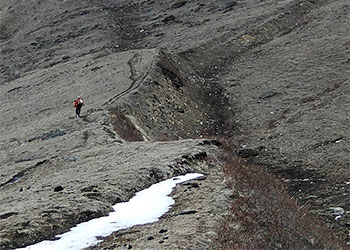Murphy Leads Team Discovering New Himalayan Active Fault System
System’s Large Surface Ruptures Responsible for Large Historical Earthquakes
 Mike Murphy, associate professor in the UH Department of Earth and Atmospheric Sciences, and colleagues discovered a complex fault system in the Himalayan Mountains of western Nepal that is characterized by large and fresh surface scarps that can be traced for as much as 63 km across the mountainous terrain.
Mike Murphy, associate professor in the UH Department of Earth and Atmospheric Sciences, and colleagues discovered a complex fault system in the Himalayan Mountains of western Nepal that is characterized by large and fresh surface scarps that can be traced for as much as 63 km across the mountainous terrain.
Field and dating studies show that the scarps were formed by as much as 10 m of surface displacement that generated magnitude 7.9 earthquakes that devastated Nepal and India between 1165 AD and 1400 AD. The fault system is part of the Western Nepal Fault System that cuts obliquely across the Himalayan Mountains. Prior to this study, this area was not recognized as a source of potentially large earthquakes known from historical records.
Research findings are discussed in the article, “Limit of Strain Partitioning in the Himalaya Marked by Large Earthquakes in Western Nepal,” which published in the January 2014 issue of Nature Geoscience.
Abstract:
Great earthquakes and high seismic risk in the Himalaya are thought to be focused near the range front, where the Indian Plate slides beneath the mountain range. However, the Himalaya is curved and plate convergence becomes increasingly oblique westwards. Strain in the western Himalaya is hypothesized to be partitioned, such that western parts move northwestwards with respect to the central Himalaya. Here we use field data to identify a 63-km-long earthquake rupture on a previously unrecognized fault in the western Himalaya, far from the range front. We use radiocarbon dating to show that one or more earthquakes created 10 m of surface displacement on the fault between AD 1165 and 1400. During this time interval, large range-front earthquakes also occurred. We suggest that the active fault we identified is part of a larger fault system, the Western Nepal Fault System, which cuts obliquely across the Himalaya. We combine our observations with a geodynamical model to show that the Western Nepal Fault System marks the termination of the strain-partitioned region of the western Himalaya and comprises a first-order structure in the three-dimensional displacement field of the mountain range. Our findings also identify a potential seismic hazard within the interior of the Himalaya that may necessitate significant changes to seismic hazard assessments.